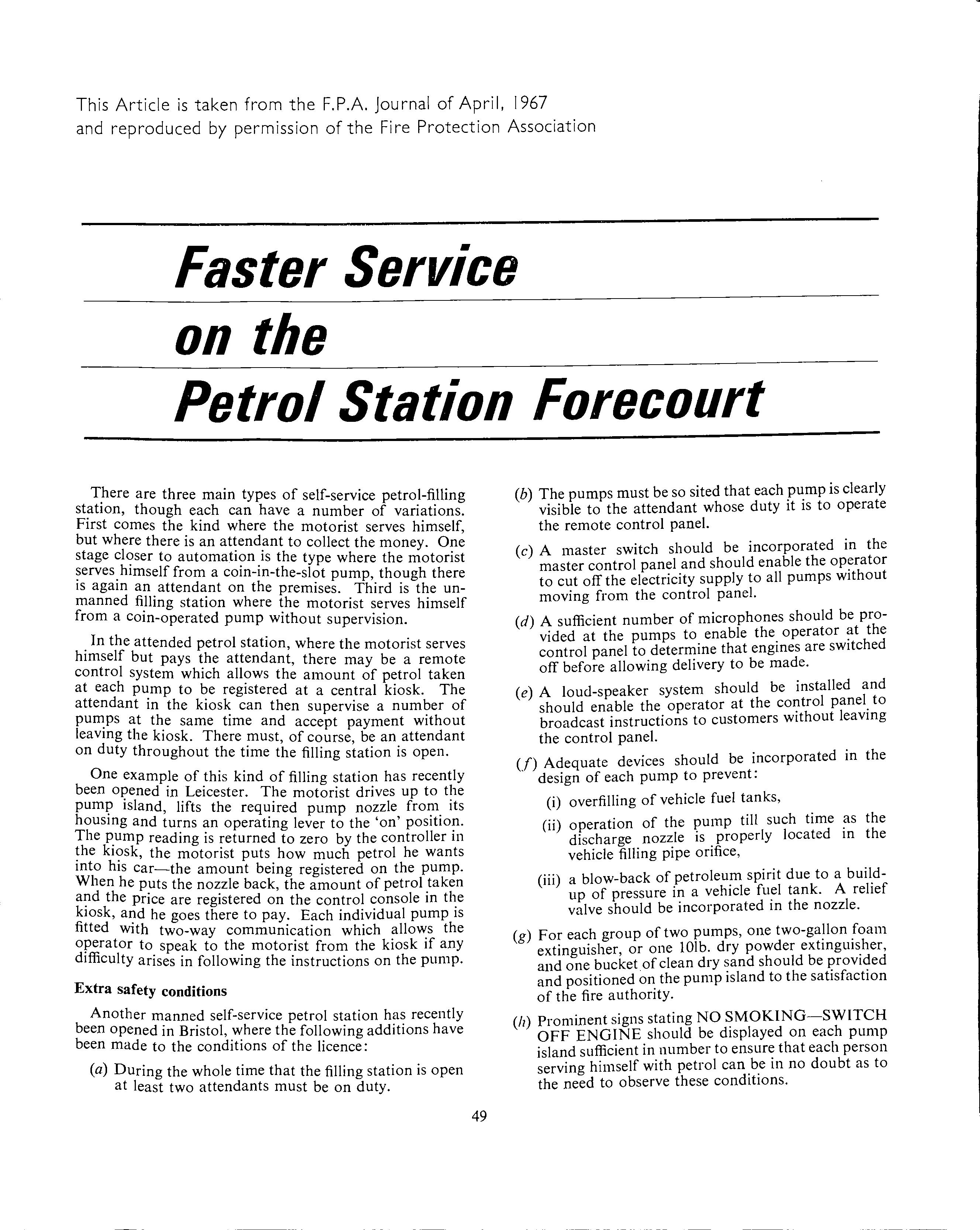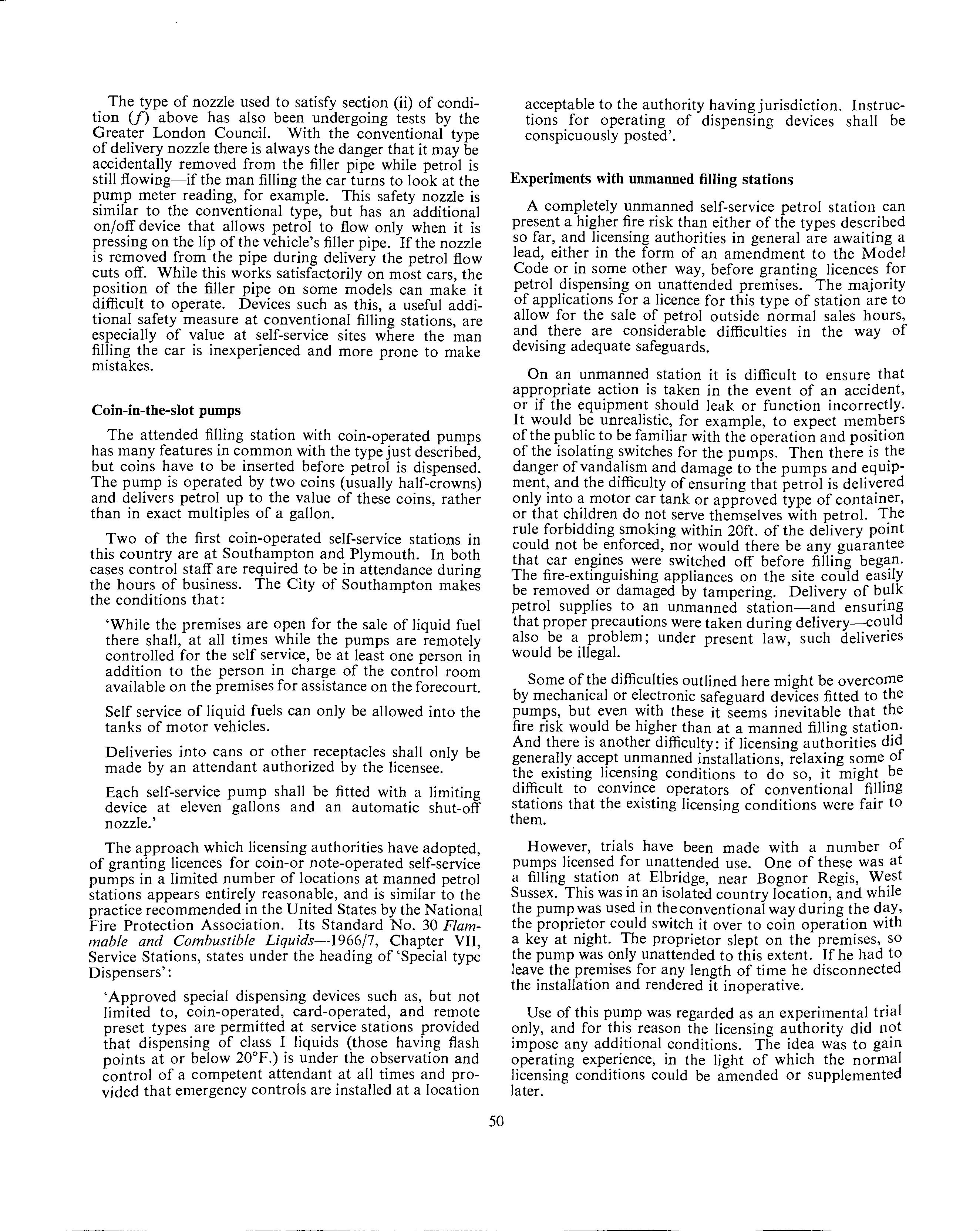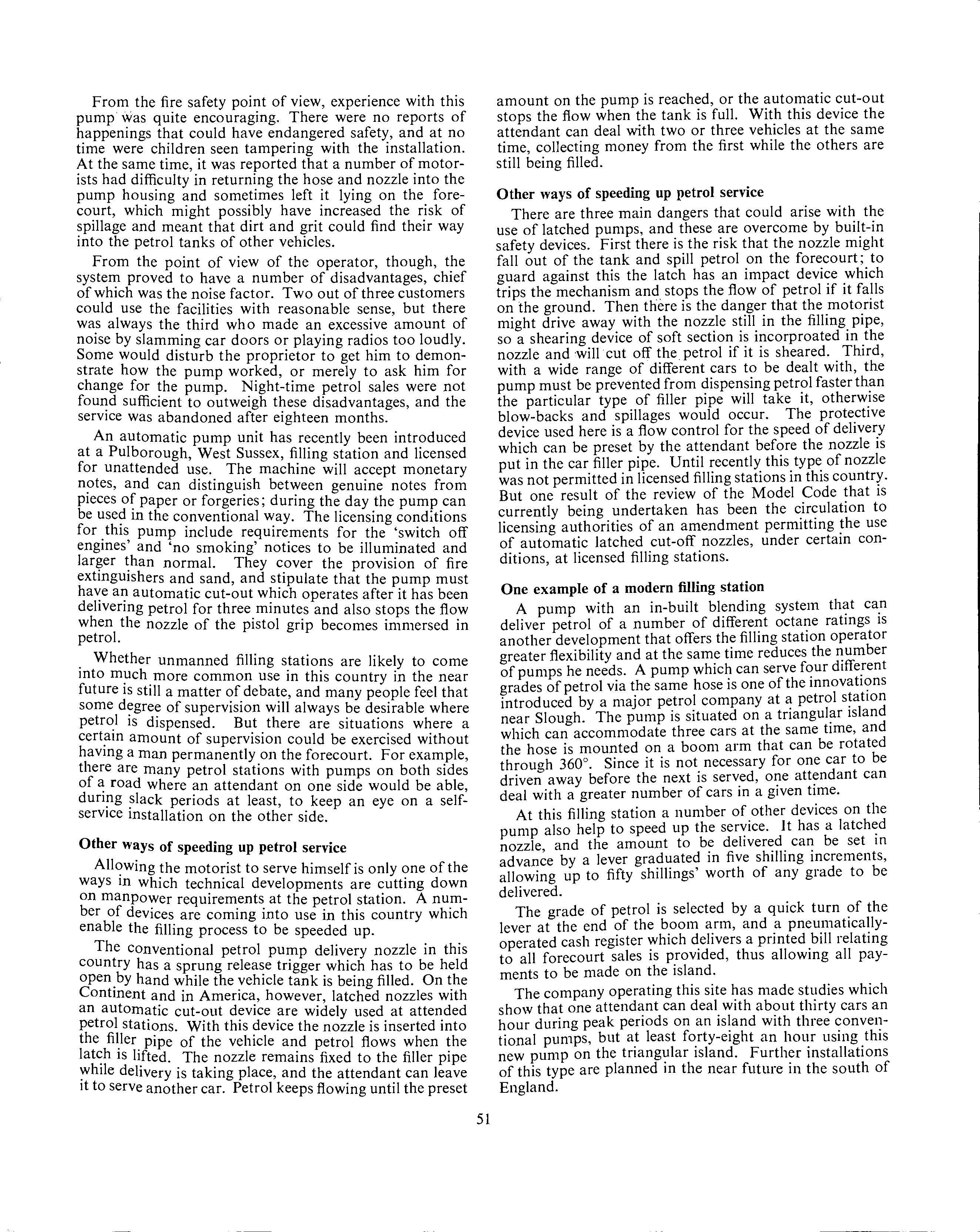
14 minute read
FASTER SERVICE ON THE PETROL STATION FORECOURT
by apeauk
This Article is taken from the F.P.A. Journal of April, 1967 and reproduced by permission of the Fire Protection Association
There are three main types of self-service petrol-filling station, though each can have a number of variations. First comes the kind where the motorist serves himself, but where there is an attendant to collect the money. One stage closer to automation is the type where the motorist ~erves_himself from a coin-in-the-slot pump, though there 1s aga10 an attendant on the premises. Third is the unmanned filling station where the motorist serves himself from a coin-operated pump without supervision. In the attended petrol station, where the motorist serves himself but pays the attendant, there may be a remote control system which allows the amount of petrol taken at each pump to be registered at a central kiosk. The attendant in the kiosk can then supervise a number of pu~ps at the same time and accept payment without leav10g the kiosk. There must, of course, be an attendant on duty throughout the time the filling station is open. One example been opened in of this kind of filling station has recently Leicester. The motorist drives up to the puml? island, lifts the required pump nozzle, froi:n. its hous10g and turns an operating lever to the 'on pos1tio!1· The p_ump reading is returned to zero by the controller 111 ~he k1<;>sk, the motorist puts how much petrol he wants 10to his car-the amount being registered on the pump. When he puts the nozzle back, the amount of petrol _taken a?d the price are registered on the control console 111 t~e kiosk, and he goes there to pay. Each individual pump is fitted with two-way communication which allows the operator to speak to the motorist from the kiosk if any difficulty arises in following the instructions on the pump. Extra safety conditions Another manned self-service petrol station has recently been opened in Bristol, where the following additions have been made to the conditions of the licence: (a) During the whole time that the filling station is open at least two attendants must be on duty.
Advertisement
49 (b) The pumps must be so sited that each p~mp is clearly visible to the attendant whose duty it is to operate the remote control panel. (c) A master switch should be incorporated in the master control panel and should enable the op~rator to cut off the electricity supply to all pumps without moving from the control panel. (d) A sufficient number of microphones should be provided at the pumps to enable the. operator ~t the control panel to determine that engmes are switched off before allowing delivery to be made. (e) A loud-speaker system should be installed and should enable the operator at the coi;itrol panel. to broadcast instructions to customers without leavmg the control panel. (f) Adequate devices should be i_ncorporated in the design of each pump to prevent. (i) overfilling of vehicle fuel tanks, (ii) operation of the pump till such time !ls the discharge nozzle is properly located 10 the vehicle filling pipe orifice, (iii) a blow-back of petroleum spirit due to up of pressure in a vehicle fu~l tank. a bui~dA rehef valve should be incorporated 10 the nozzle. (g) For each group of two pumps, one two-ga!lon .foam extinguisher, or one IOlb. dry powder ext10gms.her, and one bucket of clean dry sand should be 1?rov1~ed and positioned on the pump island to the satisfaction of the fire authority. (h) Prominent signs stating NO SMOKING-SWITCH
OFF ENGINE should be displayed on each pump island sufficient in number to ensur~ that each person serving himself with petrol can be 10 no doubt as to the need to observe these conditions.
The type of nozzle used to satisfy section (ii) of condition (f) above has also been undergoing tests by the Greater London Council. With the conventional type of delivery nozzle there is always the danger that it may be accidentally removed from the filler pipe while petrol is still flowing-if the man filling the car turns to look at the pump meter reading, for example. This safety nozzle is similar to the conventional type, but has an additional on/off device that allows petrol to flow only when it is pressing on the lip of the vehicle's filler pipe. If the nozzle is removed from the pipe during delivery the petrol flow cuts off. While this works satisfactorily on most cars, the position of the filler pipe on some models can make it difficult to operate. Devices such as this, a useful additional safety measure at conventional filling stations, are especially of value at self-service sites where the man filling the car is inexperienced and more prone to make mistakes.
Coin-in-the-slot pumps
The attended filling station with coin-operated pumps has many features in c?mmon with the type just described, but coins have to be mserted before petrol is dispensed. The pump is operated by two coins (usually half-crowns) and delivers petrol up to the value of these coins, rather than in exact multiples of a gallon.
Two of the first coin-operated self-service stations in this country are at Southampton and Plymouth. In both cases control staff are required to be in attendance during the hours of business. The City of Southampton makes the conditions that: 'While the premises are open for the sale of liquid fuel there shall, at all times while the pumps are remotely controlled for the self service, be at least one person in addition to the person in charge of the control room available on the premises for assistance on the forecourt.
Self service of liquid fuels can only be allowed into the tanks of motor vehicles.
Deliveries into cans or other receptacles shall only be made by an attendant authorized by the licensee.
Each self-service pump shall be fitted with a limiting device at eleven gallons and an automatic shut-off nozzle.'
The approach which licensing authorities have adopted, of granting licences for coin-or note-operated self-service pumps in a limited number of locations at manned petrol stations appears entirely reasonable, and is similar to the practice recommended in the United States by the National Fire Protection Association. Its Standard No. 30 Flammable and Combustible Liquids--1966/7, Chapter VII, Service Stations, states under the heading of 'Special type Dispensers': 'Approved special dispensing devices such as, but not limited to, coin-operated, card-operated, and remote preset types are permitted at service stations provided that dispensing of class I liquids (those having flash points at or below 20°F.) is under the observation and control of a competent attendant at all times and provided that emergency controls are installed at a location acceptable to the authority having jurisdiction. Instructions for operating of dispensing devices shall be conspicuously posted'.

Experiments with unmanned filling stations
A completely unmanned self-service petrol station can present a higher fire risk than either of the types described so far, and licensing authorities in general are awaiting a lead, either in the form of an amendment to the Model Code or in some other way, before granting licences for petrol dispensing on unattended premises. The majority of applications for a licence for this type of station are to allow for the sale of petrol outside normal sales hours, and there are considerable difficulties in the way of devising adequate safeguards.
On an unmanned station it is difficult to ensure that appropriate action is taken in the event of an accident, or if the equipment should leak or function incorrectly. It would be unrealistic, for example, to expect members of the public to be familiar with the operation and position of the isolating switches for the pumps. Then there is the danger of vandalism and damage to the pumps and equipment, and the difficulty of ensuring that petrol is delivered only into a motor car tank or approved type of container, or that children do not serve themselves with petrol. The rule forbidding smoking within 20ft. of the delivery point could not be enforced, nor would there be any guarantee that car engines were switched off before filling began. The fire-extinguishing appliances on the site could easily be removed or damaged by tampering. Delivery of bulk petrol supplies to an unmanned station-and ensuring that proper precautions were taken during delivery-eould also be a problem; under present law, such deliveries would be illegal.
Some of the difficulties outlined here might be overcome by mechanical or el~ctronic safeguard devices fitted to the pumps, but even with these it seems inevitable that the fire risk would be higher than at a manned filling station. And there is another difficulty: if licensing authorities did generally accept unmanned installations, relaxing some of the existing licensing conditions to do so, it might be difficult to convince operators of conventional filling stations that the existing licensing conditions were fair to them.
However, trials have been made with a number of pumps licensed for unattended use. One of these was at a filling station at Elbridge, near Bognar Regis, West Sussex. This was in an isolated country location, and while the pump was used in the conventional way during the day, the proprietor could switch it over to coin operation with a key at night. The proprietor slept on the premises, so the pump was only unattended to this extent. If he had to leave the premises for any length of time he disconnected the installation and rendered it inoperative.
Use of this pump was regarded as an experimental trial only, and for this reason the licensing authority did not impose any additional conditions. The idea was to gain operating experience, in the light of which the normal licensing conditions could be amended or supplemented later.
50
From the fire safety point of view, experience with this pump was quite encouraging. There were no reports of ~appenings that could have endangered safety, and at no time were children seen tampering with the installation. At the same time, it was reported that a number of motorists had difficulty in returning the hose and nozzle into the pump housing and sometimes left it lying on the forecourt, which might possibly have increased the risk of ~pillage and meant that dirt and grit could find their way mto the petrol tanks of other vehicles.
From the point of view of the operator, though, the system proved to have a number of disadvantages, chief of which was the noise factor. Two out of three customers could use the facilities with reasonable sense, but there was always the third who made an excessive amount of noise by slamming car doors or playing radios too loudly. Some would disturb the proprietor to get him to demonstrate how the pump worked, or merely to ask him for change for the pump. Night-time petrol sales were not fou~d sufficient to outweigh these disadvantages, and the service was abandoned after eighteen months.
An automatic pump unit has recently been introduced at a Pulborough, West Sussex, filling station and licensed for unattended u~e.. T~e machine will accept monetary n?tes, and can d1stmgmsh between genuine notes from pieces o~ paper or foq~eries; during the day the pump can be use? m the c~nvent10nal "'.ay. The for . this pump mclude reqmrements licensing conditions for the 'switch off engmes' and 'no smoking' notices to be illuminated and lar~er ~han normal. They cover the provision of fire extmgmshers an~ sand, and s!ipulate that the pump must ha".e al_l automatic cut-out which operates after it has been dehvenng petrol for three minutes and also stops the flow when the petrol. nozzle of the pistol grip becomes immersed in . Whether unmanned filling stations are likely to come mto m~ch. more common use in this country in the near future is still a matter ~f.deba~e, and many people feel that some d~gre~ of superv1s10n will always be desirable where petr~I Is dispensed. But there are situations where a cert::im amount of supervision could be exercised without havmg a man permanently on the forecourt. For example, there are many petrol stations with pumps on both sides of~ road where an attendant on one side would be able, dun!1g ~lack periods at least, to keep an eye on a selfserv1ce mstallation on the other side.

Other ways of speeding up petrol service
All~wing the motorist to serve himself is only one of the ways m which technical developments are cutting down on manpo~er requirements at the petrol station. A number of devices are coming into use in this country which enable the filling process to be speeded up.
The conventional petrol pump delivery nozzle in this country has a sprung release trigger which has to be held open _by hand while the vehicle tank is being filled. On the Contment and in America, however, latched nozzles with an autom~tic cut-<;>ut d~vice !ire widely used at attended phetrol stations. With this device the nozzle is inserted into t e fil_ler. pipe of the vehicle and petrol flows when the lat~h is h_fted. The nozzle remains fixed to the filler pipe ~htle delivery is taking place, and the attendant can leave it to serve another car. Petrol keeps flowing until the preset amount on the pump is reached, or the automatic cut-out stops the flow when the tank is full. With this device the attendant can deal with two or three vehicles at the same time, collecting money from the first while the others are still being filled. Other ways of speeding up petrol service
There are three main dangers that could arise with the use of latched pumps, and these are overcome by built-in safety devices. First there is the risk that the nozzle might fall out of the tank and spill petrol on the forecourt; to guard against this the latch has an impact device which trips the mechanism and stops the flow of petrol if it falls on the ground. Then there is the danger that the motorist might drive away with the nozzle still in the filling pipe, so a shearing device of soft section is incorproated in the nozzle and will cut off the. petrol if it is sheared. Third, with a wide range of different cars to be dealt with, the pump must be prevented from dispensing petrol faster than the particular type of filler pipe will take it, otherwise blow-backs and spillages would occur. The protective device used here is a flow control for the speed of delivery which can be preset by the attendant before the nozzle is put in the car filler pipe. Until recently this type of nozzle was not permitted in licensed filling stations in this country. But one result of the review of the Model Code that is currently being undertaken has been the circulation to licensing authorities of an amendment permitting the use of automatic latched cut-off nozzles, under certain conditions, at licensed filling stations. One example of a modern filling station
A pump with an in-built bl~nding system th~t ca_n deliver petrol of a number of different octane ratmgs 1s another development that offers the filling station operator greater flexibility and at the same time reduces the number of pumps he needs. A pump which can serve four diffe_rent grades of petrol via the same hose is one of the innovatl<;>ns introduced by a major petrol company at a petrol s~at10n near Slough. The pump is situated on a trianguI::ir island which can accommodate three cars at the same time, and the hose is mounted on a boom arm that can be rotated through 360°. Since it is not necessary for one car to be driven away before the next is served, one attendant can deal with a greater number of cars in a given time.
At this filling station a number of other devices on the pump also help to speed up the service. It has a latched nozzle, and the amount to be delivered can be set in advance by a lever graduated in five shilling increments, allowing up to fifty shillings' worth of any grade to be delivered.
The grade of petrol is selected by a quick turn of the lever at the end of the boom arm, and a pneumaticallyoperated cash register which delivers a printed bill relating to all forecourt sales is provided, thus allowing all payments to be made on the island.
The company operating this site has made studies which show that one attendant can deal with about thirty cars an hour during peak periods on an island with three conventional pumps, but at least forty-eight an hour using this new pump on the triangular island. Further installations of this type are planned in the near future in the south of England.
51







